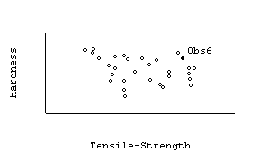

 Course
Outline || Technical Support || Syllabus || What's
New? ||
Course
Outline || Technical Support || Syllabus || What's
New? ||
Lesson 1: A Gentle Introduction to Statistics
Professor Sungur and I (Anderson) both think that being a statistician
is the greatest job in the world. I think it is like being a data
detective. We look at a relatively small amount of quantitative information
and observe what it has to tell us about a larger research problem.
In this course we will show you some of the ways that we can learn important
things about the world from data. You will then be on your way to
becoming a data detective too!
In this lesson we will show you how statistics is applied to real-world
problems. Do the assigned reading on the cdrom, follow the suggested
WWW links, and do the class activity described below. Enjoy!!
-
Reading Assignment. Read Chapter
1 in the ActivStats cdrom.
-
Investigate the following examples from other Internet
sites:
-
Class Activity
Along with your course materials you received by mail you should have received
a small box of raisins with instructions to NOT open the box. Well,
you should now open the box, but don't eat the raisins,... at least not
for a few more minutes. We would like you to count the number of
raisins in your box, again, before eating any of them, and enter the number
of raisins in the box below:
The question we are interested in is how many raisins are in one of
these small boxes on average? In other words, what is a typical number
of raisins in a box? Do you think that all the students in
the class will have the same number of raisins? Well, probably not
because SunMaid can't probably fill the boxes precisely enough to get exactly
the same number of raisins in each box. How consistent are they in
filling the boxes?
We can't examine every box ever filled, but we can examine a small number
of boxes, (your boxes), and learn something about how well the boxes are
filled. Let's look at our results.
This display is called a dotplot. One dot is placed next to the
number of raisins found by each student. For example, in my box of
raisins, I got ? raisins. One of the dots next to ? is from my result.
Where are most of the dots? Well by looking at the display
we can see that most students got somewhere between ? and ? raisins per
box. This display quickly informs us that SunMaid boxes typically
have around ? raisins in them.
You will also notice that not all boxes had the same number of raisins
in them. From the display you can see that the values range from
? to ? raisins in each box. This gives you an idea of how precisely
the machines filled the boxes in this batch of raisins.
From this lesson we hope that you have been able to see that statistical
applications are just about everywhere in the world. It is
actually very difficult to think of any academic subject areas, or career
professions that don't involve statistics in some way. In fact,
here is a challenge for you... if you can think of something that doesn't
involve statistics, Professor Sungur will pay you a large ($$$$) reward.
Post your ideas to the discussion board and we will procede to shoot them
down. Such confidence we have!!
-
Suppose you worked in a factory that bottled Coca-Cola, and your job was
to ensure that the bottles were filled to the correct amount, say 2 liters.
How would you decide if the machines that fill the bottles were working
properly? Post your responses to the discussion board.
-
Recent news programs have found that dairies and juice companies have been
underfilling milk and juice containers sent to public school lunch programs.
This underfilling of containers costs school districts=taxpayers mega-bucks.
How could you discover if containers in your school district were being
underfilled? Again, post your responses to the discussion
board.


